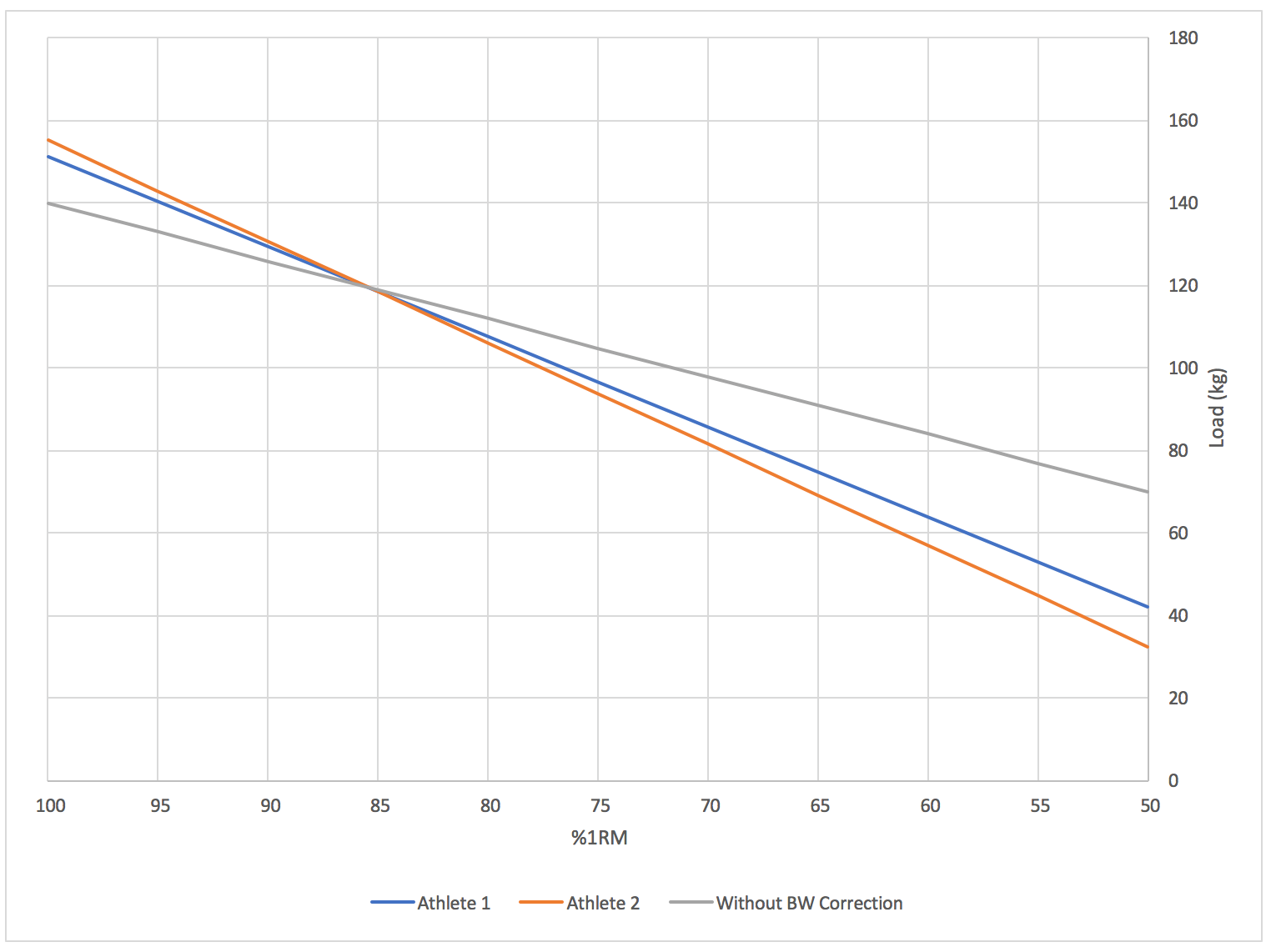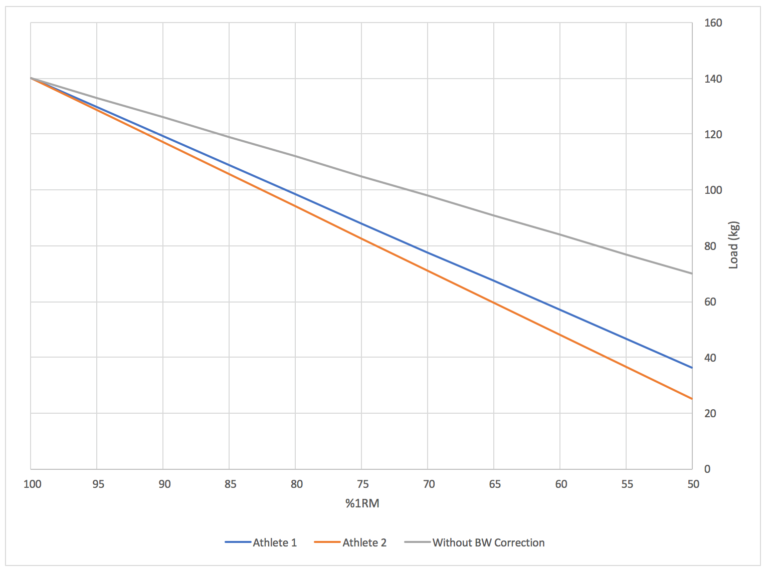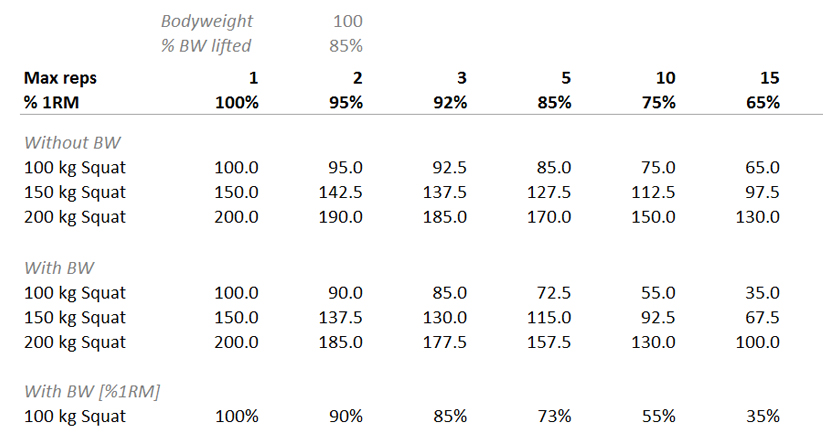Physical Preparation for Team Sports: Establishing 1RMs (ADDENDUM)
This is the addendum to the Physical Preparation for Team Sports: Establishing 1RMs. I forgot to address two very important topics – use of total system load vs external load, and methods of comparing individuals (relative strength and allometric scaling). I have also covered ‘exceptions’ to 1RM testing (such as isoPush and isoInertial exercises).
Since the topic of using total system load as opposed to external load is no ‘clear cut’, I welcome any comments and feedback.
Total System Load vs. External Load?
Imagine we have two athletes who weight 75kg and 100kg and they both perform 5 pull-ups with extra 20kg attached using dip belt. What is their 1RM?

If we use only external load (in this case 20kg) and we use Epley formula, both athletes will have 23kg 1RM in the pull-ups. You might ask: “Yeah, but they are lifting their own bodyweight”. And you would be correct. For this reason, we need to utilize ‘total system load’, which is, in this case, bodyweight plus external load.

As can be seen, Athlete 2 has much higher 1RM since he is heavier.
Now that we have 1RMs, how do we calculate the weights that need to be lifted using a percent-based approach? For example, if a program calls for doing 3×8 with 75% 1RM?

By multiplying 75% with 1RM, we got 83kg for Athlete 1 and 105kg for Athlete 2. That is also a total system load that needs to be lifted for 8 reps. In order to get external load, we need to deduct bodyweight.

So, in order to perform 3×8 with 75% 1RM, Athlete 1 needs to add extra 8kg and Athlete 2 needs to add extra 5 kg.
If you use even lower percentages, there would be a point where you would need to deduct the load, either by using elastic bands, or by using a special equipment (or moving to pull-down machine).
To estimate 1RMs for the assistance movements, for example DB Rows, one would use body weight corrected 1RM in the pull-ups. Since 1RM for single arm DB Row is 33% of 1RM of the pull-ups, for Athlete 1 that would be 33% x 111kg, or 36kg.
The above example using pull-ups is quite intuitive, but now let’s compare bench press and back squat. Using basic wooden dowel (assuming 0kg external load), would you be able to do more reps on the bench press, or on the back squat? You will be able to do much more reps on the bench press with wooden dowel, in comparison with the back squat. Why is that? Because, when you do squats, you are also lifting your bodyweight. The same relationship should hold true if we compare, let’s say, maximum number of reps with 50% of 1RM between back squat and bench press. You are more likely to do more reps on the bench press.
According to the biomechanical research, the load you are lifting in the squat is approximately 90% of your bodyweight. This is pretty much your body without the lower legs (which are around 10% of your bodyweight).
Should we then take into account 90% of bodyweight when we estimate load for the lower body lifts? Let’s use the same two athletes and compare 1RMs with and without BW correction (in this case 90% of BW). Both athletes lifted 120kg for 5 reps in the back squat:

Taking Athlete 1 as an example, total system load would be 120kg + 90% of 75kg, which is 120 + 67.5, or 187.5kg. Using Epley formula to estimate 1RM, we get (187.5 x 5 x 0.0333) + 187.5, which equals 219kg (see table).
Let’s assume that we prescribe 3 sets of 8 reps with 75%. Let’s compare two methods of estimating the load:

As can be seen, load estimated using 1RM without BW correction is the same for both athletes (105kg), but different when we use BW corrected 1RM (97kg for Athlete 1 and 94kg for Athlete 2).
Let’s estimate how these three differ across the continuum of loads (from 100% to 50% of 1RM).

Things look much clearer when plotted:

As can be seen, there are discrepancies between load estimation using bodyweight correction (total system load) and load estimation without bodyweight correction (using only external load). It can be seen that, as percentages decrease, total system load approach estimates lower and lower loads to be lifted, especially for the heavier athlete. From the figure above, it can also be seen that 1RM estimated with reps-to-failure using total system load, is higher than 1RM estimated using external load. That is most likely due to the fact that original Epley formula doesn’t take into account bodyweight, but only external load.
Let’s assume that the true 1RM is being tested and we know with certainty what is the external 1RM. In that case, we can just add 90% of bodyweight to the total system 1RM:

And now when the numbers get plotted, we get the following graph:

It is logical to conclude that two athletes with the same 1RM (in this case 140kg), but with different body weights, should be using different loads in training. This should hold true both with pull-ups and squats. But things are not that straight forward and it is very easy to fall into the rabbit hole. When it comes to back squat example, I am not sure if there is any research on reliability of Epley formula, (or any other estimate of 1RM using reps-to-failure) when one uses total system load as opposed to using external load only. So in this case, our 1RM estimation can be unreliable to begin with (especially if we haven’t performed true 1RM test as seen in the two examples above), as well as a number of reps performed at certain percentage of it. Secondly, the load estimation for assistance exercises becomes cumbersome using total system load method. For example, according to Dan Baker’s table, 1RM of Romanian Deadlift (RDL) is approximately 75% of the back squat 1RM. This is straight forward when we use external load method, but when using total system load the calculus becomes much more complex, since we are not lifting 90% of body weight in the RDL. So we are back to “precision vs importance” dichotomy. My approach is to utilize the simplest approach possible, which gives me enough of actionable insights that I can start using right away and be able to update as I go. Besides, we are always dealing with ‘estimates’ so, therefore, there is a lot of uncertainty involved already. And making things more complex on top of uncertain metrics is not my cup of tea (although it is good exercise in futility).
But before I wrap up total system vs external load approaches, let’s take one more example. If we know athlete’s 1RM in the bench press, we might want to estimate how much external load that athlete needs to use in the push-up movement (for example putting weight vest, plate on the back or using dip belt when elevated). If you put your arms on the scale in the push-up position, you can estimate that around 70% of your weight is supported on your arms (this, of course, depends on the body type, but 70% will be ‘good enough’ estimate). Taking our two athletes as an example, both with 120kg 1RM in the bench press, we want to estimate external load for the push-up, when we prescribe sets of 8 with 75% 1RM.

As can be seen from the table, knowing athletes’ bench press 1RM and assuming 70% of bodyweight is supported in the push-up, calculated external load for sets of 8 reps with 75% 1RM are 15kg for Athlete 1 and -2.5kg for Athlete 2 (which means he needs to ‘deduct’ some weight, or do less reps). The reverse process can also be utilized – we can estimate bench press 1RM from push-up reps-to-failure performance:

Let’s wrap up the issue of total system load vs. external load approaches. First of all, we are dealing with estimates that are inherently uncertain (except when performing true 1RM test, but even with that, we are uncertain about assistance exercise 1RMs) – type of movement, experience, gender, motivation, body built and other, all affect reps-to-failure method reliability of estimating 1RM, and especially estimating assistance movements 1RMs and later training prescription loads (e.g. what %1RM we should use for 3 sets of 10 for upper vs. lower body movement). The question is why? Why do we need 1RMs for? In my opinion, besides being an evaluation of performance, we need it to prescribe loads. And for that, we need to lean more toward ‘significance’ in ‘precision-significance’ continuum, and to utilize ‘satisficing’ philosophy. Or, in other words, having ‘something’ to work with without killing the athletes. So, it is a form of heuristic that we use to prescribe training.
It seems logical that total system load approach can be used with, let’s say, pull-up movements and push-up movements (essentially bodyweight), in which external load is not close to the bodyweight. With lower body movements, such as squats and deadlifts, using external load approach will suffice. Might not be the most precise, but it is good enough to prescribe training. There will always be individual differences, exercise differences, estimation formula differences, but it is up to us to deal with all these uncertainties by using simple rules, but also realizing and understanding all the assumptions involved.
Some coaches, such as great Dan Baker, utilize very simple heuristic when doing higher reps training for upper vs. lower body movements:











Responses